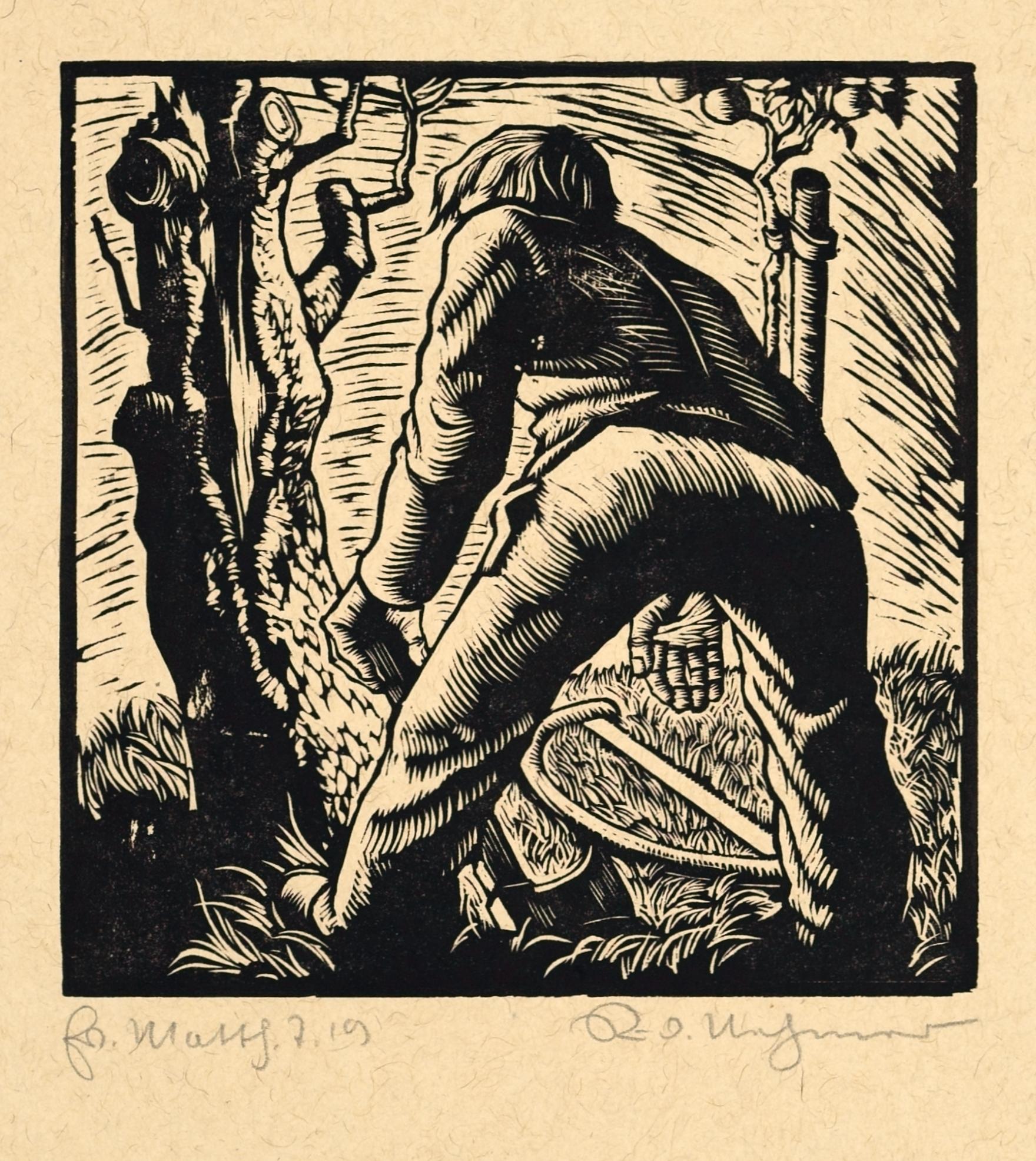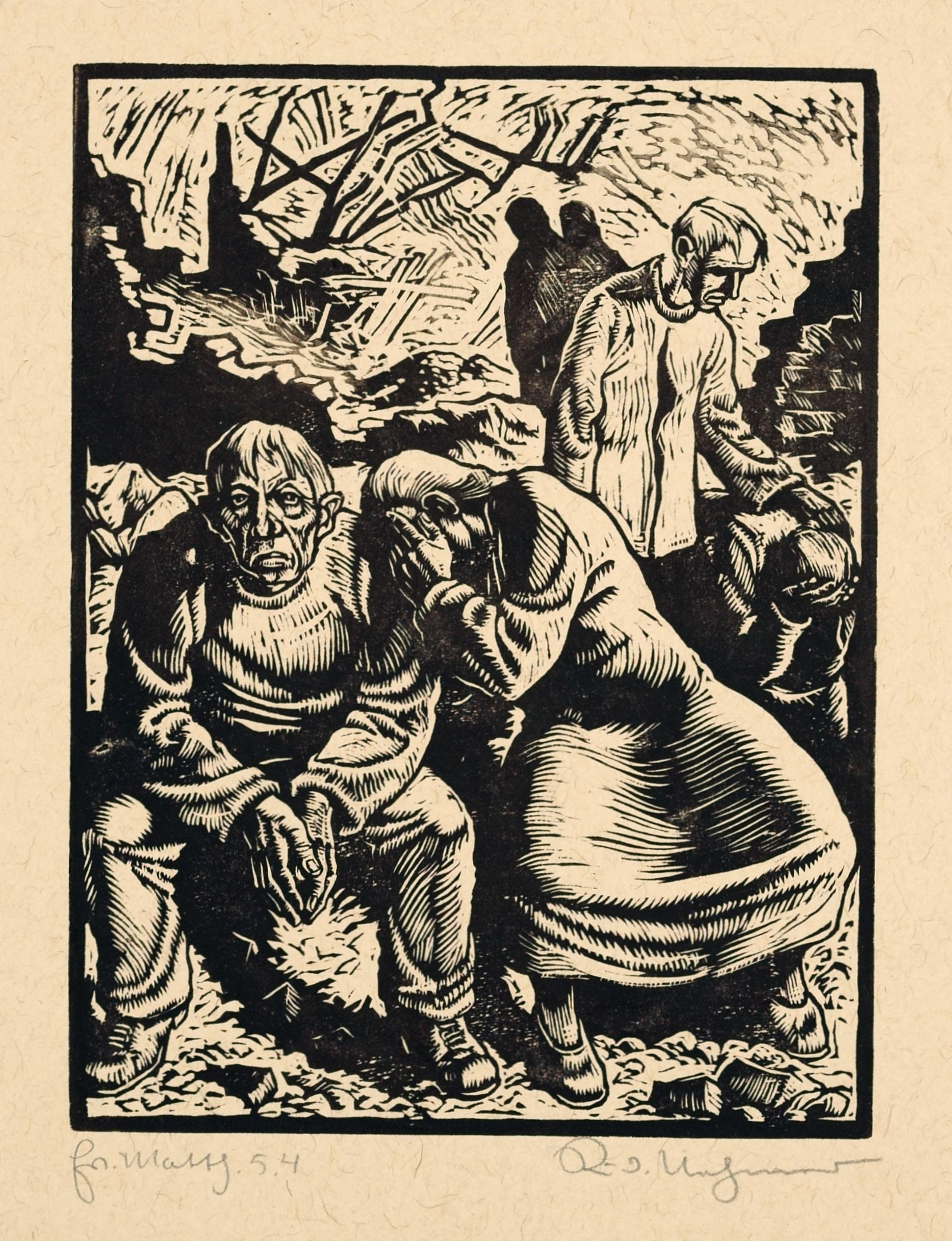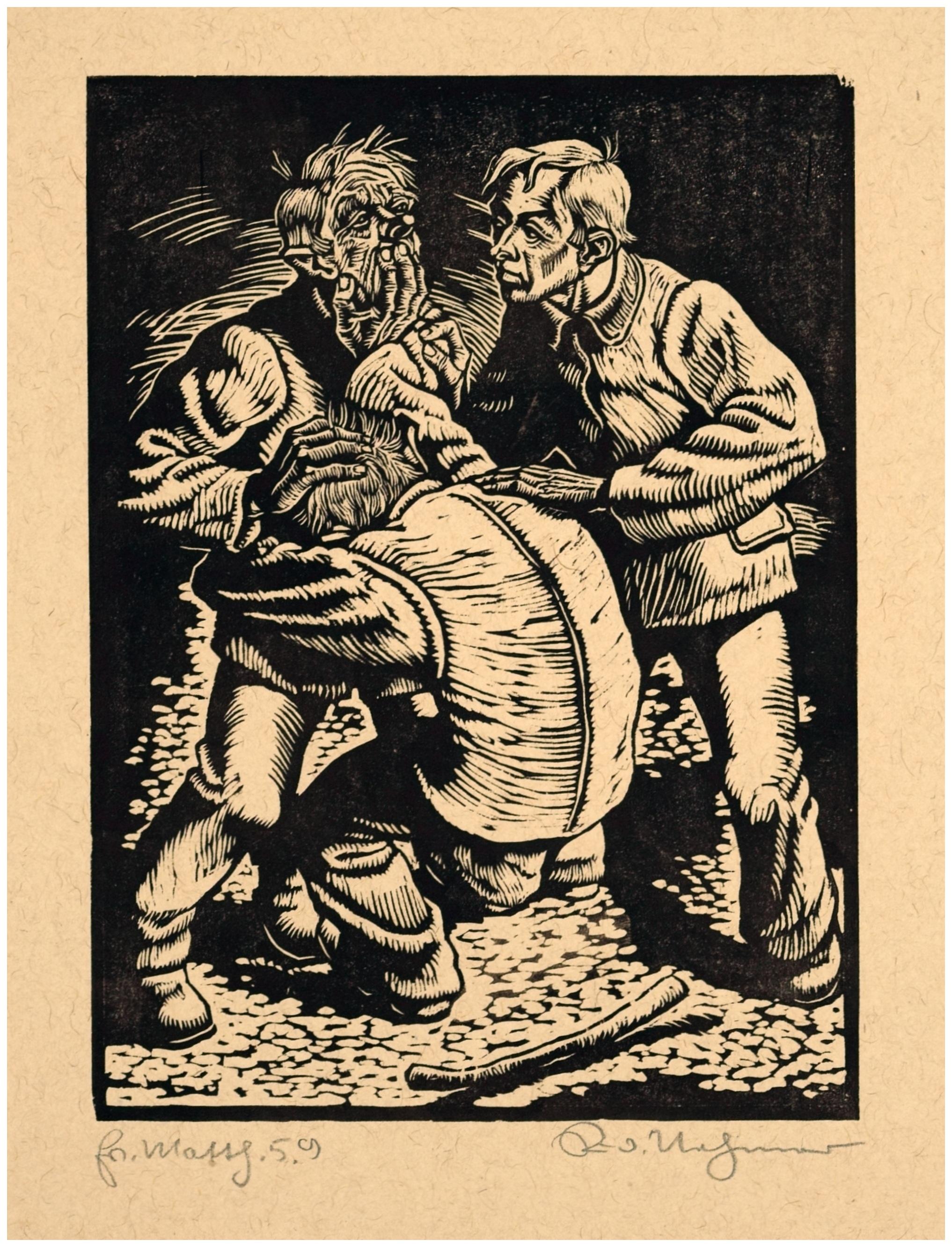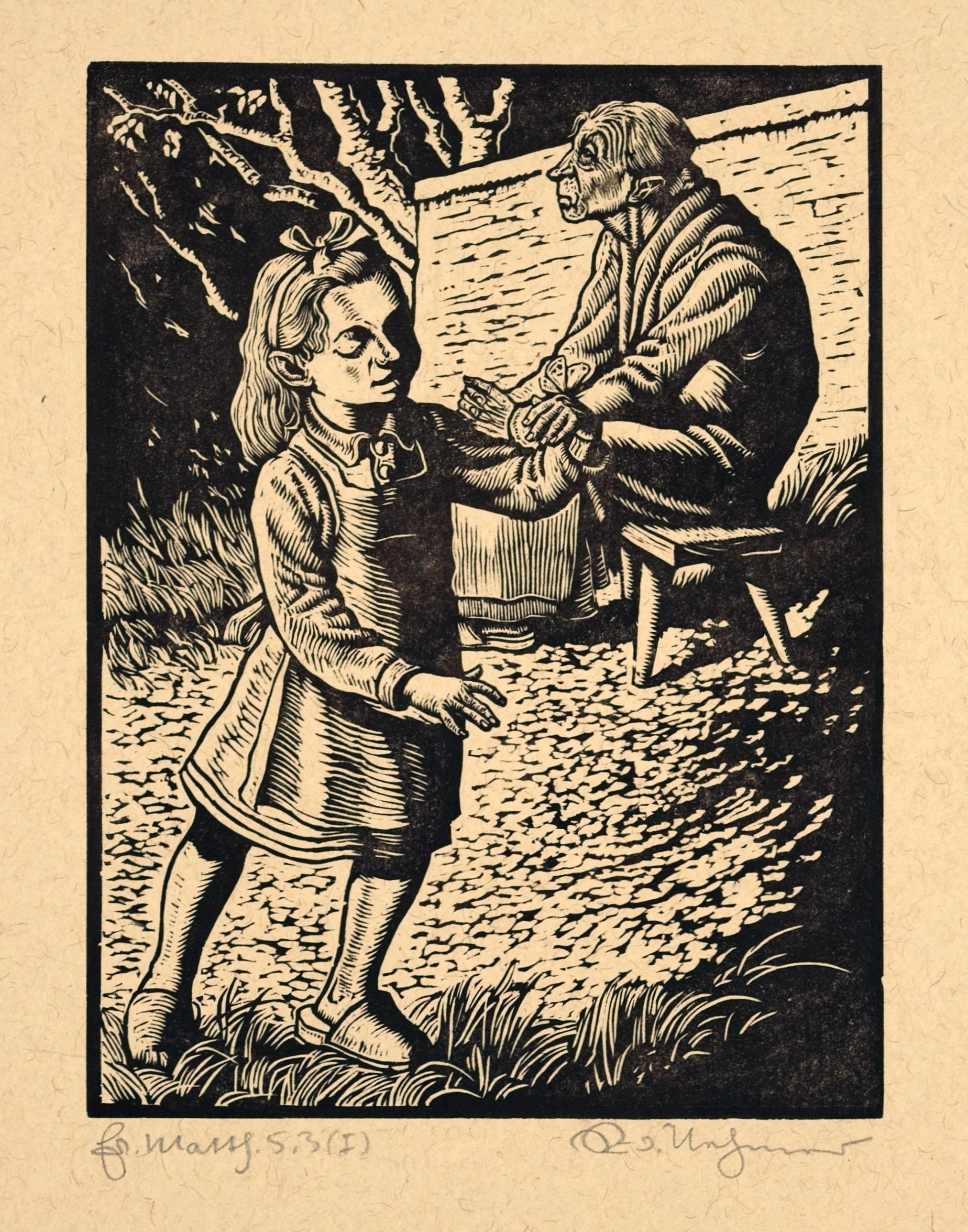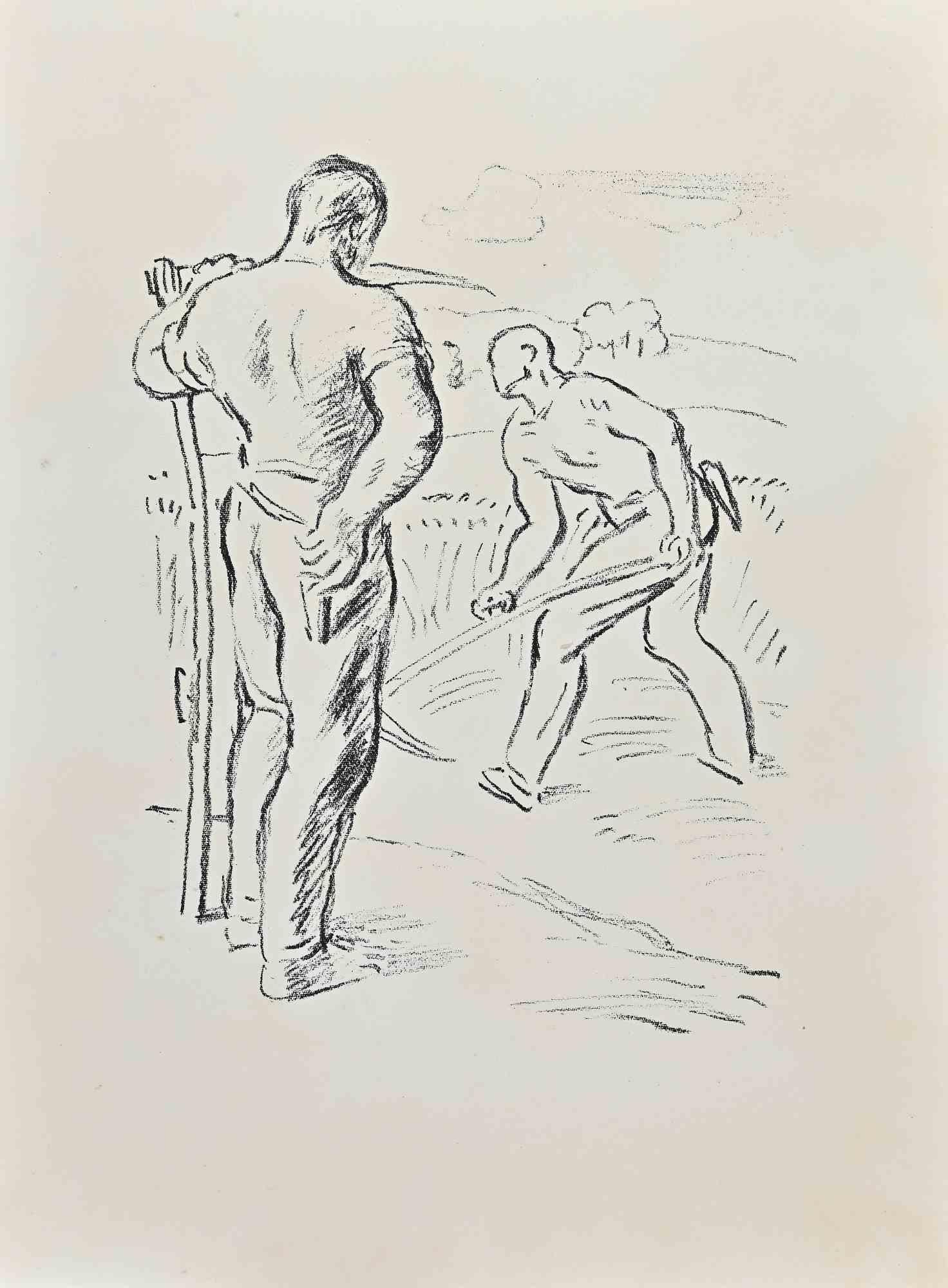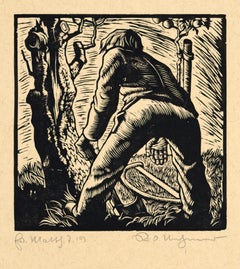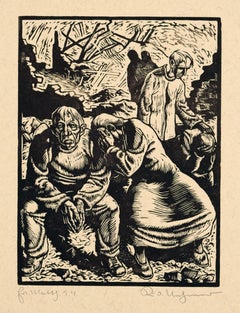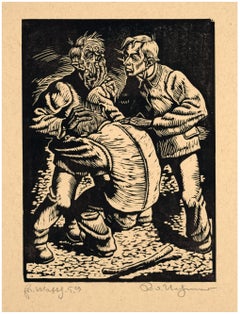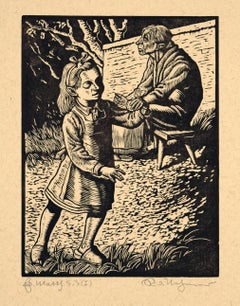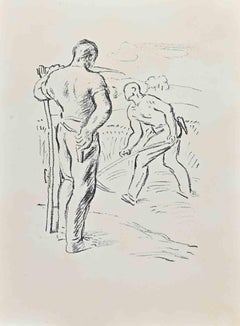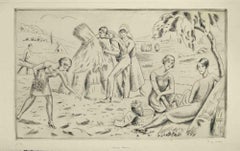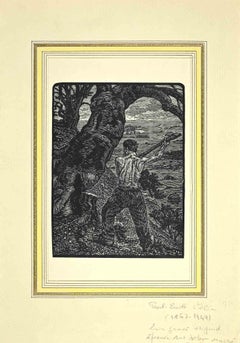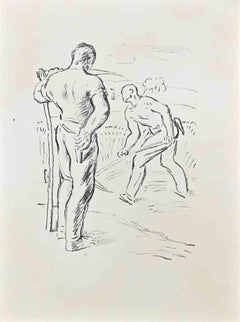Items Similar to The Fieldman and Death / - Sowing and Harvest -
Want more images or videos?
Request additional images or videos from the seller
1 of 8
Rudolf NehmerThe Fieldman and Death / - Sowing and Harvest -1948
1948
$225.51
$281.8920% Off
£172.17
£215.2120% Off
€192
€24020% Off
CA$318.40
CA$39820% Off
A$349.41
A$436.7620% Off
CHF 182.50
CHF 228.1220% Off
MX$4,177.54
MX$5,221.9220% Off
NOK 2,311.64
NOK 2,889.5520% Off
SEK 2,156.04
SEK 2,695.0520% Off
DKK 1,462.65
DKK 1,828.3120% Off
About the Item
Rudolf Nehmer (1912 Bobersberg - 1983 Dresden), The Fieldman and Death, around 1948. Woodcut on yellowish wove paper, 16.8 cm x 15.8 cm (depiction), 42 cm x 30 cm (sheet size), signed “Rud.[olf] Nehmer” in pencil lower right.
- The wide sheet margin somewhat wavy, minimally light-stained, the image in excellent, colorful condition.
- Sowing and Harvest -
In this painting Rudolf Nehmer reflects on the immediate catastrophic past. He refers to the medieval story "The Farmer from Bohemia" by Johannes von Tepl, but instead of a dialogue with Death, Death sits behind the farmer and sharpens his scythe while the farmer tills the field. The result is not a blooming landscape, but a dead landscape of Death - an inverted sacred grove from which Death will bring home his harvest.
About the artist
Rudolf Nehmer studied from 1932 to 1934 in Dresden at the private art academy founded by Ernst Oskar Simonson-Castelli under Woldemar Winkler and, after a brief interlude at the art academy, was a student in Willy Kriegel's studio until 1936. After his first one-man show in 1935 at the Kühl Art Exhibition in Dresden, which was progressive until the Nazi era, Nehmer was represented at the major German art exhibitions in the following years. In 1938 he stayed in Worpswede. From 1941 he was a soldier on the Western Front and in Denmark, returning to Dresden from British captivity in 1945. After the war, he had his first solo exhibition in 1945. Nehmer was a co-founder of the artists' association 'Das Ufer - Gruppe 1947' and in 1951 a founding member of the artists' cooperative 'Kunst und Zeit'. He had numerous solo and group exhibitions in the GDR, culminating in a retrospective at the Galerie Neuer Meister on the occasion of his 60th birthday.
GERMAN VERSION
Rudolf Nehmer (1912 Bobersberg - 1983 Dresden), Der Ackermann und der Tod, um 1948. Holzschnitt auf gelblichem Velin, 16,8 cm x 15,8 cm (Darstellung), 42 cm x 30 cm (Blattgröße), unten rechts in Blei mit „Rud.[olf] Nehmer“ signiert.
- Der breite Blattrand etwas gewellt, minimal lichtrandig, die Darstellung in ausgezeichnetem farbkräftigem Zustand.
- Aussaat und Ernte -
Rudolf Nehmer reflektiert mit diesem Bild die unmittelbare katastrophale Vergangenheit. Dazu bezieht er sich auf die mittelalterliche Erzählung „Der Ackermann aus Böhmen“ von Johannes von Tepl. Statt eines Dialogs mit dem Tod sitzt der Tod hier allerdings dem Ackermann im Rücken und schärft seine Sense, während der Bauer das Feld bestellt. Es entstehen keine blühenden Landschafen, sondern eine abgestorbene Todeslandschaft – ein invertierter Heiliger Hain, von dem aus der Tod seine Ernte heimbringen wird.
zum Künstler
Rudolf Nehmer studierte von 1932 bis 1934 in Dresden an der von Ernst Oskar Simonson-Castelli gegründeten privaten Kunstakademie bei Woldemar Winkler und war – nach einem kurzen Intermezzo an der Kunstakademie – bis 1936 Schüler im Atelier von Willy Kriegel. Nach einer ersten Einzelausstellung im Jahre 1935 in der bis in die NS-Zeit hinein progressiven Dresdner Kunstausstellung Kühl, war Nehmer in den Folgejahren in den Großen Deutschen Kunstausstellungen vertreten. 1938 weilte er in Worpswede. Ab 1941 war er Soldat an der Westfront und in Dänemark und kehrte 1945 aus britischer Kriegsgefangenschaft nach Dresden zurück. Nach dem Kriegsende erfolgte bereits 1945 die erste Einzelausstellung. Nehmer war Mitbegründer der Künstlervereinigung ‚Das Ufer – Gruppe 1947‘ und war 1951 Gründungsmitglied der Künstlergenossenschaft ‚Kunst und Zeit‘. In der DDR erfolgten zahlreiche Einzelausstellungen und Ausstellungsbeteiligungen, die in einer Retrospektive anlässlich seines 60. Geburtstags in der Galerie Neuer Meister gipfelte.

About the Seller
5.0
Vetted Professional Seller
Every seller passes strict standards for authenticity and reliability
Established in 2014
1stDibs seller since 2023
22 sales on 1stDibs
- ShippingRetrieving quote...Shipping from: Berlin, Germany
- Return Policy
More From This Seller
View AllThe fruitless tree / - The End of the Grotesque Era -
Located in Berlin, DE
Rudolf Nehmer (1912 Bobersberg - 1983 Dresden), The fruitless tree, 1948. Woodcut on yellowish wove paper, 15 cm x 14.6 cm (image), 45 cm x 30 cm (sheet size), signed “Rud.[olf] Nehm...
Category
1940s Realist Figurative Prints
Materials
Woodcut
$169 Sale Price
20% Off
The Zero Hour / - After the End of the World -
Located in Berlin, DE
Rudolf Nehmer (1912 Bobersberg - 1983 Dresden), The Zero Hour, 1948. Woodcut on yellowish wove paper, 20 cm x 14.8 cm (image), 43 cm x 30 cm (sheet size), signed “Rud.[olf] Nehmer” i...
Category
1940s Realist Figurative Prints
Materials
Woodcut
$263 Sale Price
20% Off
Blessed are the peacemakers / - Dehumanization -
Located in Berlin, DE
Rudolf Nehmer (1912 Bobersberg - 1983 Dresden), Blessed are the peacemakers, 1948. Woodcut on yellowish wove paper, 18 cm x 15.5 cm (image), 45 cm x 30 cm (sheet size), signed “Rud.[...
Category
1940s Realist Figurative Prints
Materials
Woodcut
$169 Sale Price
20% Off
Blessed are the spiritually poor / - The Abundance of Poverty -
Located in Berlin, DE
Rudolf Nehmer (1912 Bobersberg - 1983 Dresden), Blessed are the spiritually poor, 1948. Woodcut on yellowish wove paper, 20 cm x 15 cm (image), 45 cm x 30 cm (sheet size), signed “Ru...
Category
1940s Realist Figurative Prints
Materials
Woodcut
$178 Sale Price
20% Off
Blessed are the merciful / - The support of care -
Located in Berlin, DE
Nehmer, Rudolf (1912-1983), Blessed are the merciful, 1948
Rudolf Nehmer (1912 Bobersberg - 1983 Dresden), Blessed are the merciful, 1948. Woodcut on yellowish wove paper, 18.8 cm x ...
Category
1940s Realist Figurative Prints
Materials
Woodcut
$178 Sale Price
20% Off
Greed / - The Poverty of Wealth -
Located in Berlin, DE
Rudolf Nehmer (1912 Bobersberg - 1983 Dresden), The birds under the sky, 1948. Woodcut on yellowish wove paper, 11 cm x 18 cm (depiction), 43 cm x 30 cm (sheet size), signed “Rud.[ol...
Category
1940s Realist Figurative Prints
Materials
Woodcut
$169 Sale Price
20% Off
You May Also Like
Farmers - Lithograph by W. Gimmi - 1955 ca.
Located in Roma, IT
Farmers is a lithograph on ivory-colored paper realized by Wilhelm Gimmi in 1955 ca.
Very Good Conditions. Not signed, as issued.
The artwork is created in a realistic style throug...
Category
Early 20th Century Modern Figurative Prints
Materials
Lithograph
The Harvest - Etching by Paul Emile Colin - 1930s
Located in Roma, IT
Etching and drypoint realized by Paul Emile Colin in 1930s.
Edition of 5/60. Hand signed and numbered in pencil.
Very good condition.
Category
1930s Modern Figurative Prints
Materials
Etching
The Woodcutter - Woodcut by Paul Emile Colin - Early 20th Century
Located in Roma, IT
Woodcut print realized by P.E. Colin (1867-1949) in the early 20th Century.
On Japan paper.
Matted.
Very good condition.
Category
Early 20th Century Modern Figurative Prints
Materials
Woodcut
Farmers - Lithograph by W. Gimmi - 1955 ca.
Located in Roma, IT
Farmers is an original lithograph on ivory-colored paper realized by Wilhelm Gimmi in 1955 ca.
Very Good Conditions. Nos signed. as issued.
The artwork is created in a realistic st...
Category
1950s Modern Figurative Prints
Materials
Lithograph
$234 Sale Price
20% Off
La Cosecha (The Harvest)
Located in Palm Springs, CA
Image size: 18 x 12 inches
Sheet size: 15x22 inches
Edition size: 21
Depicts farm worker contemplating his fields in Mexico.
Dark brown ink on cream-colored 100% archival cotton-r...
Category
2010s Contemporary Landscape Prints
Materials
Screen
Farmers - Lithograph by W. Gimmi - 1955 ca.
Located in Roma, IT
Farmers is a lithograph on ivory-colored paper realized by Wilhelm Gimmi in 1955 ca.
Very Good Conditions. Not signed, as issued.
The artwork is created in a realistic style thro...
Category
Early 20th Century Modern Figurative Prints
Materials
Lithograph
More Ways To Browse
Brian Clarke
Bruno Schulz
Caroline Durieux On Sale
Chagall Arabian Nights
Chagall In The Land Of Gods
Chagall Maternity
Chagall Paysage
Chagall Romeo
Chagall Ruth Gleaning
Chagall Signed Poster
Christ And The Rembrandt
Christian Silvain
Clemens Briels On Sale
Collier Picasso
Corneille Bleu
Cristina Martinez
Dali Alice In Wonderland
Dali Aliyah
